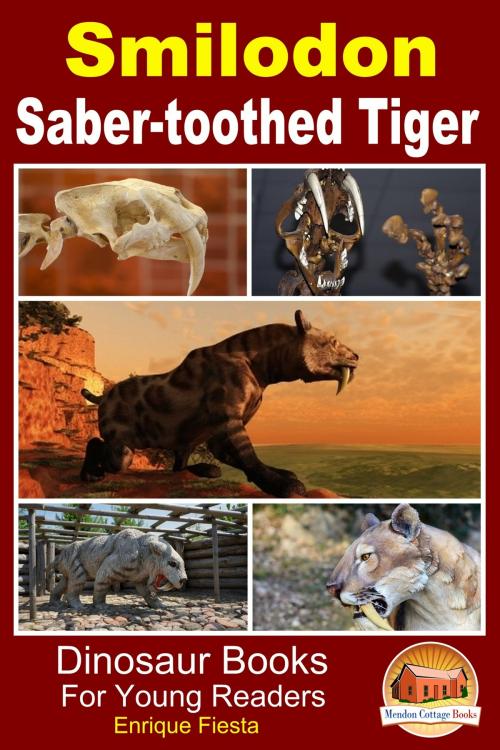| Author: | Enrique Fiesta | ISBN: | 9781310777226 |
| Publisher: | Mendon Cottage Books | Publication: | December 3, 2014 |
| Imprint: | Smashwords Edition | Language: | English |
| Author: | Enrique Fiesta |
| ISBN: | 9781310777226 |
| Publisher: | Mendon Cottage Books |
| Publication: | December 3, 2014 |
| Imprint: | Smashwords Edition |
| Language: | English |
Smilodon - Saber-toothed Tiger
Table of Contents
Introduction
Chapter 1: Appearance
Chapter 2: Behavior
Chapter 3: Environment
Conclusion
Author Bio
Introduction
Greetings young reader! Today we are going to take a step back in time and enter the age of prehistoric mammals. Mammals are animals with hair or fur that secrete milk for their babies, and typically give birth to live young as opposed to laying eggs. These prehistoric mammals are an extinct species of animal that began to live on the Earth about 2.5 million years ago. Some of them still thrived as recently as 10,000 years ago. “Extinct” means that they no longer exist. These prehistoric mammals are some of the most intriguing and awe-inspiring animals that have existed on our planet. The prehistoric mammals’ strange shapes, sizes, and behaviors make them inherently worthy of study and interest. Even more than these reasons, the study of these mammals itself is an incredible adventure which requires thought and imagination. The study of prehistoric animals helps you to appreciate just how mysterious nature really is. Our planet supports not only us and the animals that live today, but it even supported creatures as gigantic and strange as the giant sloths and huge cave dwelling bears- just think how cool that is! I hope that you bring a spirit of openness and wonder to your study of the prehistoric animals, and that you come to appreciate the mystery and value of this imaginative adventure.
Today we are going to discuss the Smilodon. The Smilodon is also commonly referred to as the saber-tooth tiger or saber-tooth cat because of its long canines. We are going to learn about the Smilodon and explore the world that it lived in. We know what we know about the prehistoric mammals from a variety of sources including fossils, biology, and other scientific disciplines. Fossils are the ancient remains of these animals, the most familiar being their bones. Biological science is the study of life in general, but many scientists compare prehistoric animals to modern day animals to support their theories.
Before a talk about animals can take place it is important that we discuss the theory of evolution. Evolutionary theory purports that all the animals we know and see today are the direct descendants of animals that existed millions of years ago. The dinosaurs and other creatures that existed millions of years ago either died out or gradually changed into different animals. For instance, birds are considered to be surviving dinosaurs because their dinosaur ancestors survived the dinosaur extinction event (we will discuss this later). The prehistoric mammals’ ancestor was an animal that outlived the dinosaurs and survived the extinction event.
Remember that any time you see an * next to the name of an animal, it means that a book has been written about this animal in the Dinosaur Books for Young Readers series. Any word written in bold is an important scientific term which is defined in-text. Italics are used to denote the first time an animal’s name is mentioned in the book.
Smilodon - Saber-toothed Tiger
Table of Contents
Introduction
Chapter 1: Appearance
Chapter 2: Behavior
Chapter 3: Environment
Conclusion
Author Bio
Introduction
Greetings young reader! Today we are going to take a step back in time and enter the age of prehistoric mammals. Mammals are animals with hair or fur that secrete milk for their babies, and typically give birth to live young as opposed to laying eggs. These prehistoric mammals are an extinct species of animal that began to live on the Earth about 2.5 million years ago. Some of them still thrived as recently as 10,000 years ago. “Extinct” means that they no longer exist. These prehistoric mammals are some of the most intriguing and awe-inspiring animals that have existed on our planet. The prehistoric mammals’ strange shapes, sizes, and behaviors make them inherently worthy of study and interest. Even more than these reasons, the study of these mammals itself is an incredible adventure which requires thought and imagination. The study of prehistoric animals helps you to appreciate just how mysterious nature really is. Our planet supports not only us and the animals that live today, but it even supported creatures as gigantic and strange as the giant sloths and huge cave dwelling bears- just think how cool that is! I hope that you bring a spirit of openness and wonder to your study of the prehistoric animals, and that you come to appreciate the mystery and value of this imaginative adventure.
Today we are going to discuss the Smilodon. The Smilodon is also commonly referred to as the saber-tooth tiger or saber-tooth cat because of its long canines. We are going to learn about the Smilodon and explore the world that it lived in. We know what we know about the prehistoric mammals from a variety of sources including fossils, biology, and other scientific disciplines. Fossils are the ancient remains of these animals, the most familiar being their bones. Biological science is the study of life in general, but many scientists compare prehistoric animals to modern day animals to support their theories.
Before a talk about animals can take place it is important that we discuss the theory of evolution. Evolutionary theory purports that all the animals we know and see today are the direct descendants of animals that existed millions of years ago. The dinosaurs and other creatures that existed millions of years ago either died out or gradually changed into different animals. For instance, birds are considered to be surviving dinosaurs because their dinosaur ancestors survived the dinosaur extinction event (we will discuss this later). The prehistoric mammals’ ancestor was an animal that outlived the dinosaurs and survived the extinction event.
Remember that any time you see an * next to the name of an animal, it means that a book has been written about this animal in the Dinosaur Books for Young Readers series. Any word written in bold is an important scientific term which is defined in-text. Italics are used to denote the first time an animal’s name is mentioned in the book.















